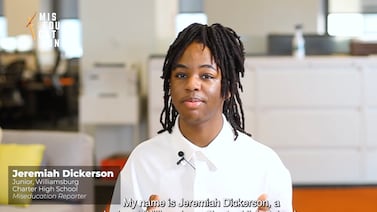As Colorado leaders prepare for the second year of the state’s popular new universal preschool program, they’re grappling with a hotly debated question.
How many 4-year-olds in a classroom is too many?
Since the $322 million preschool program launched in August, the state has allowed classes of up to 24 children and required one staff member for every 12 students. But many experts and observers believe those numbers are too high and undermine the state’s promise to provide high-quality preschool. They want class sizes capped at 20 and staff-to-student ratios limited to 1 to 10.
Last fall, state leaders appeared ready to phase in the 20-student class size and 1-to-10 ratio limits by 2025. But they’ve faced months of pushback, mostly from private preschool providers. A state advisory committee has also recommended the rules allowing higher class sizes and ratios stay in place.
The final decision rests with Lisa Roy, executive director of the Colorado Department of Early Childhood. She said in a statement she’s weighing research on the topic and feedback from the advisory committee, and will decide by March 28.
The class size debate highlights one of the key tensions in Colorado’s new preschool program: the need to balance what’s best for young children with cold financial realities. Not only is early childhood education a notoriously low-margin business, but there’s limited state funding for the program.
This year, about 39,000 4-year-olds receive 10 to 30 hours of tuition-free preschool through the program — 62% of that age group in the state. Next year, enrollment is expected to rise.
Because preschool is funded per student, many providers who’ve argued for keeping universal preschool classes of 24 students have warned they’ll lose tens of thousands of dollars annually if they have to drop down to 20 children per classroom and one staff member for every 10 students.
In addition, some say such rules would lead to tuition hikes for hours not covered by universal preschool, push providers to drop out of the universal program, or force them to close their doors permanently.
Dozens of preschool providers and early childhood groups have submitted written comments to the state in recent months about the proposed preschool quality rules. A few providers have endorsed smaller class sizes and lower staff-to-student ratios — but most have not, and several have sharply criticized them.
One private provider suggested that lower class sizes and ratios make sense for preschools run by public schools — which serve most young students with special needs — but not for private preschools. A few commenters noted that Montessori preschools often incorporate 24 or more children of varying ages because students work more independently in such programs.
Ron Montoya, who with his wife owns a Goddard School child care franchise in Westminster, said in an interview that class sizes of 20 would mean he’d have to cut eight universal preschool seats — four from each of his two 4-year-old classrooms.
Fewer spots for children, he said, run counter to “the mandate from the voters and from the governor.”
Universal preschool is one of Gov. Jared Polis’ signature initiatives and is funded partly with a voter-approved nicotine tax. Preschools get about $6,000 for every child enrolled for 15 hours a week. That funding is set to increase by only 2% — about $120 — next year.
Montoya also worries that lost revenue stemming from the proposed class size cap could make it harder to pay teachers a competitive wage.
Class size data hard to pin down
One of the biggest unanswered questions in the class size conflict is how many of the 1,932 preschools in Colorado’s universal program actually have classes of 24 students and staff-to-student ratios of 1 to 12. The state doesn’t track that number.
That makes it hard to know how many universal preschool seats would be lost by changing class size rules. Some preschool providers say thousands of seats would disappear statewide. At the same time, state officials say up to 150 new preschools are poised to join the universal program for the 2024-25 school year, adding new slots to the total.
While Colorado’s licensing rules have long allowed 24 4-year-olds in preschool classes and staff-to-student ratios of 1 to 12, many providers operate with lower numbers for logistical or historical reasons.
Some classrooms simply don’t have the square footage required by the state to accommodate that many kids. Plus, Colorado’s previous state-funded preschool program, which served children with risk factors mostly in public schools, capped class sizes at 16 and staff-student ratios at 1 to 8.
The Durango school district in southwest Colorado continues to run its 13 preschool classrooms with 16 children per class and one staff member for every eight students even though it’s no longer required.
“I think it’s best for kids,” said Jennifer Baufield, the district’s early childhood coordinator. “Our teachers are better able to meet their needs.”
Much is expected of early childhood teachers and smaller class sizes make it easier, she said: “Being a preschool teacher is a stressful job.”
The Denver district, Colorado’s largest, has taken a different tack than Durango. It bumped up class sizes from 16 to 20 when the state’s new universal preschool began last summer.
But Priscilla Hopkins, the district’s executive director of early education, said that’s as high as the district will go except for Montessori classroom settings.
“I like keeping class sizes as manageable as possible because you want strong supervision and high-quality programming and attention for students,” she said.
Denver’s move to a maximum 20 students per class will lead to around 20 preschool classroom closures across the district next year because it will take fewer classrooms to hold the same number of students.
“We are just being efficient and consolidating programs,” Hopkins said.
Experts say smaller class sizes are better
Early childhood groups, including the National Institute for Early Education Research at Rutgers University and the National Association for the Education of Young Children, recommend preschool class size maximums of 20 children and staff-to-student ratios of 1 to 10.
Many states with large, publicly funded preschool programs hew to those limits, too.
At a December meeting of the state’s Early Childhood Leadership Commission, co-chair Susan Steele acknowledged the tension in creating high quality preschool with limited funding, but said other states have managed.
“How can they have higher [teacher training] requirements? How can they have lower group sizes? How is that possible other places and not in Colorado? I mean, it doesn’t make sense to me,” she said.
Research on class size is mixed, with some studies finding social, behavioral, or literacy gains for children in smaller classes and others finding no effects. A 2017 study that analyzed decades of research concluded that class size caps of 20 and staff-to-student ratios of 1 to 10 “are largely adequate for most children.”
The same year, another group of researchers that analyzed dozens of studies on staff-to-student ratios concluded that other efforts to boost preschool quality, such as staff training, might yield “better payoffs” than reducing ratios.
Alissa Mwenelupembe, managing director of early learning at the National Association for the Education of Young Children, said it’s clear that young children profit from deep connections with trusted adults.
“There is a point in the size of the group where those deep connections cannot happen,” she said. “The reality is the smaller the group size, the more individual attention and support children can get in the classroom.”
But Mwenelupembe is also sympathetic to preschool providers who’ve long operated with 24 children per class and fear losing money if Colorado’s proposed stricter limits come to pass.
“I think it’s really challenging to turn a ship,” she said. “At the end of the day, we do think lower ratios are better, but we also can’t let go of the fact that early learning programs have to be able to be viable businesses.”
Ann Schimke is a senior reporter at Chalkbeat, covering early childhood issues. Contact Ann at aschimke@chalkbeat.org.





